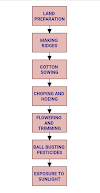COTTON FIBRE: PART 1
 |
| COTTON BALL |
Organic cotton is cotton that is produced without the use of chemicals, pesticides or synthetic substances inside of it.
1) It can take as little as 1-5months to completely biodegrade, close to an apple core that takes 2 months.
2) Cotton fibre is the purest source of cellulose and the most significant natural fibre.
3) The economic significance of cotton in the global market is evident by its majority share (over 50%) among fibres for apparel and textile goods.
4) Both the market value and the quality of cotton products are directly related to fibre quality.
5) Cotton fibre is a plant derived natural seed fibre used extensively in the manufacture of denim fabrics.
6) Major producers of cotton fibre are China, India, US, Pakistan and Brazil. These countries produce about 80% of cotton globally.
7) Cotton fibre is a plant seed fibre that needs to be harvested and then separated from the seed.
8) Harvesting is carried out by handpicking the cotton boll from the field or by automatic harvesting using a spindle picker.
9) Cotton is a soft, fluffy staple fibre that grows in a boll, or protective case, around the seeds of the cotton plants of the genus Gossypium in the mallow family Malvaceae.
- TYPES OF COTTON FIBRE:
There are four commercially grown species of cotton. All domesticated in antiquity:
• Gossypium hirsutum: upland cotton, native to central America, Mexico, the Caribbean and Southern Florida(90% of world production)
• Gossypium barbadense: Known as extra – long staple cotton, native to tropical south America(8% of world production)
• Gossypium arboretum: Tree cotton, native to India and Pakistan (Less than 2%)
• Gossypium herbaceum: Levant cotton, native to southern Africa and the Arabian Peninsula (Less than 2%).
The two new world cotton species account for the vast majority of modern cotton production, but the two old world species were widely used before the 1900s. While cotton fibres occurs naturally in colours of white, brown, pink and green, fears of contaminating the genetics of white cotton have led many cotton growing locations to ban the growing of coloured cotton varieties.
- MORPHOLOGY OF COTTON FIBRE:
 |
| MORPHOLOGY OF COTTON |
The cotton fibre is a single plant cell. It has a distinct cuticle, well developed primary and secondary walls, and a lumen.
CUTICLE:
The “cuticle” is the outer waxy layer, exists very outside of the cotton fibre. Cuticle consists of pectin and proteinaceous materials. It serves as a smooth, water-resistant coating, which protects the fibre from chemical and other degrading agents. The waxy nature of the cuticle enables it to adhere tenaciously to the primary wall of the fibre. This layer is removed from the fibre by scouring.
PRIMARY WALL:
The “primary wall” is the original thin cell wall, which is immediately present underneath the cuticle . It is 200nm thick. It mainly consists of cellulose or network of small strands of cellulose, called fibrils. The fibrils spiral at about 70° to the fibre axis. This spiralling imparts strength to the primary cell, and hence, to the fibre. This makes for a well-organized system of continuous, very fine capillaries. The fine surface capillaries of each cotton fibre contribute greatly to cotton’s wipe-dry performance.
SECONDARY WALL:
The “secondary wall” layers of cellulose consist of concentric layers present beneath the primary cell wall , which constitutes the main portion of the cotton fibre. After the fibre has attained its maximum diameter, new layers of cellulose fibrils are added to form the secondary wall. Its fibrils are about 10 nm thick, but of undefined length. Near the primary cell wall, the fibrils of the secondary wall spiral at about 20° to 30° to the fibre axis. The fibrils are packed close together, again, forming small capillaries. As the fibrils change the direction of their spirals, a weak area exists in the secondary wall structure which results in weak areas are responsible for alternation of the direction of the twists of the convolutions.
LUMEN:
The “lumen” is the hollow canal that runs the length of the fibre. It is filled with cell sap during the growth period. The lumen was once the central vacuole of the growing cotton fibre . After the fibre matures and the boll opens, the protoplast dries up, and the lumen naturally collapses, leaving a central void in each fibre. When the sap evaporates , its constituents remain behind to contribute to the colour of the cotton fibre . As the sap evaporates, the pressure inside the fibre become less than the atmospheric pressure on the outside. This caused the fibre to collapse inward resulting in the bean or kidney-shaped cross-section of the cotton fibre.
- REFERANCE:
Published By:
Anjali Sanjaykumar Bachhav
Dept. Of Textile Technlogy,
DKTE Textile and Engineering Institute.
bachhavanjali2@gmail.com





0 Comments